
Rangoli is an art form that originates from in the Indian subcontinent, in which patterns are created on the floor or a tabletop using materials such as powdered lime stone, red ochre, dry rice flour, coloured sand, quartz powder, flower petals, and coloured rocks. It is an everyday practice in many Hindu households, however making it is mostly reserved for festivals and other important celebrations as it is time consuming. Rangolis are usually made during Diwali or Tihar, Onam, Pongal, and other Hindu festivals in the Indian subcontinent, and are most often made during Diwali. Designs are passed from one generation to the next, keeping both the art form and the tradition alive.

Kerala mural paintings are the frescos depicting Hindu mythology in Kerala. Ancient temples and palaces in Kerala, India, display an abounding tradition of mural paintings mostly dating back between the 9th to 12th centuries CE when this form of art enjoyed royal patronage.

Cheriyal scroll painting is a stylized version of Nakashi art, rich in the local motifs peculiar to the Telangana. They are at present made only in Hyderabad, Telangana, India. The scrolls are painted in a narrative format, much like a film roll or a comic strip, depicting stories from Indian mythology, and intimately tied to the shorter stories from the Puranas and Epics. Earlier, these paintings were prevalent across Andhra, as also various other parts of the country, albeit flavoured with their distinct styles and other local peculiarities dictated by the local customs and traditions. In the same way, Cheriyal scrolls must have been popular across Telangana in earlier times, though with the advent of television, cinemas and computers it has been fenced into its last outpost, the Cheriyal town.

Kondapalli is a industrial and residential hub located in western part of Vijayawada in the Indian state of Andhra Pradesh. Dr Narla Tata Rao Thermal Power Station, one of the major Thermal Power stations of the state is located in between Ibrahimpatnam and Kondapalli. It is home for many industries like Andhra Pradesh Heavy Machinery & Engineering Limited (APHMEL), BPCL, HPCL, IOC, Reliance Industries, Lanco Infratech are located here. Kondapalli Toys are very famous in the state. Kondapalli Fort, also known as Kondapalli Kota, is located towards west of Kondapalli. The closest locality to Kondapalli is Ibrahimpatnam.

Veerabhadra temple is a Hindu temple located in the Lepakshi, in the state of Andhra Pradesh, India. The temple is dedicated to the Virabhadra, a fierce incarnation of Lord Shiva. Built in the 16th century, the architectural features of the temple are in the Vijayanagara style with profusion of carvings and paintings at almost every exposed surface of the temple. It is one of the centrally protected monuments of national importance and is considered one of the most spectacular Vijayanagara temples. The fresco paintings are particularly detailed in very bright dresses and colours with scenes of Rama and Krishna from the epic stories of the Ramayana, the Mahabharata and the Puranas and they are well preserved. There is a very large Nandi (bull), mount of Shiva, about 200 metres (660 ft) away from the temple which is carved from a single block of stone, which is said to be one of the largest of its type in the world. The temple is home to many Kannada inscriptions as its located close to Karnataka border.
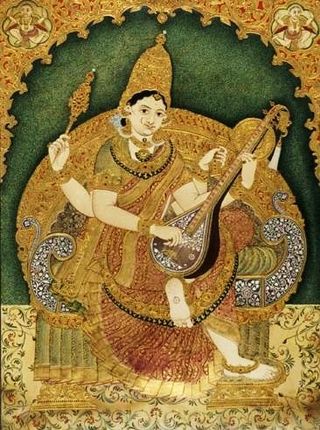
Mysore painting is an important form of classical South Indian painting style that originated in and around the town of Mysore in Karnataka encouraged and nurtured by the Mysore rulers. Painting in Karnataka has a long and illustrious history, tracing its origins back to the Ajanta Caves period. The distinct school of Mysore painting evolved from the paintings during the Vijayanagara Empire period, the rulers of Vijayanagara and their feudatories encouraged literature, art and architecture as well as religious and philosophical discussions. With the fall of the Vijayanagara Empire after the 1565 Battle of Talikota, the artists who were until then under royal patronage migrated to various places such as Mysore, Tanjore and Surpur among others. Absorbing the local artistic traditions and customs, the erstwhile Vijayanagara school of painting gradually evolved into the many styles of painting in South India, including the Mysore and Tanjore schools of painting.

Channapatna toys are a particular form of wooden toys and dolls that are manufactured in the town of Channapatna in the Ramanagara district of Karnataka state, India. This traditional craft is protected as a geographical indication (GI) under the World Trade Organization, administered by the Government of Karnataka. As a result of the popularity of these toys, Channapatna is known as the Gombegala Ooru (toy-town) of Karnataka. Traditionally, the work involved lacquering the wood of the Wrightia tinctoria tree, colloquially called Aale mara (ivory-wood).

The culture of Andhra Pradesh is an integral part Gadwal, Venkatagiri, Pedana, Bandarulanka, Uppada and Mangalairi, the exclusive metal ware, brass, stone and wood carving from Budithi in Srikaklulam District and Veenas from Bobbili and colourful toys from Etikoppaka and Kondapalli highlight the immense talent of the Andhra Pradeshi's.
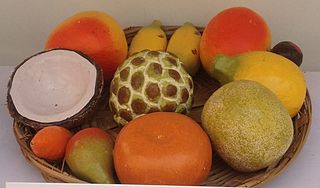
Kinnal Craft or Kinhal Craft, is a traditional wooden craft local to the town of Kinhal, or Kinnal, in Koppal District, Karnataka, India.

Patachitra or Pattachitra is a general term for traditional, cloth-based scroll painting, based in the eastern Indian states of Odisha, West Bengal and parts of Bangladesh. Patachitra artform is known for its intricate details as well as mythological narratives and folktales inscribed in it. Pattachitra is one of the ancient artworks of Odisha, originally created for ritual use and as souvenirs for pilgrims to Puri, as well as other temples in Odisha. Patachitras are a component of an ancient Bengali narrative art, originally serving as a visual device during the performance of a song.

Kalamkari is a type of hand-painted cotton textile produced in the Indian state of Andhra Pradesh. Only natural dyes are used in Kalamkari, which involves twenty-three steps.
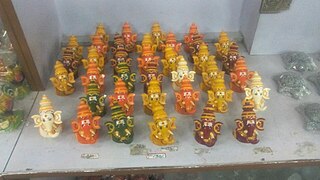
Nirmal toys are traditional Indian wooden toys made in the town of Nirmal in the Adilabad district in the state of Telangana in India. The Telugu movie “Radha krishna” is based on these toys
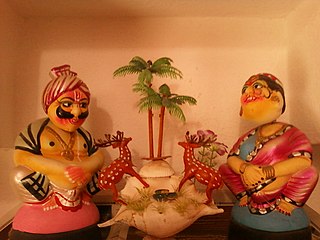
Kondapalli Toys are toys made of wood in Kondapalli of Krishna district, a nearby Vijayawada in the Indian state of Andhra Pradesh. Bommala Colony translates to Toys Colony in Kondapalli is the place where the art of crafting takes place. It was registered as one of the geographical indication handicraft from Andhra Pradesh as per Geographical Indications of Goods Act, 1999. This GI application was filed by LIGHT and Kondapalli Wooden Toys Manufacturers.These toys were one of the varieties of toys assembled in the houses during the festivals of Sankranti and Navratri and is referred as Bommala Koluvu.

Bagh print is a traditional Indian handicraft originating in Bagh, Dhar district of Madhya Pradesh, India. The process is characterised by hand printed wood block relief prints with naturally sourced pigments and dyes. Bagh print motifs are typically geometric, paisley, or floral compositions design, dyed with vegetable colours of red and black over a white background, and is a popular textile printing product. Its name is derived from the village Bagh located on the banks of the Bagh River.
Varnam is a social enterprise that has been working with artisans in Channapatna, Karnataka in India, for over 4 years. It has produced a series of designs interpreting this 200-year-old toy-making craft in the home and lifestyle, women's accessories space, giving tradition a contemporary twist. Using traditional lac-turnery methods popularised by the traditional Channapatna toys range, the label produces home and lifestyle products, toys and jewellery.

Srikalahasti Kalamkari is a style of Kalamkari work which involves dyed hand-painting of a fabric. It is produced in Srikalahasti of Tirupati district in the Indian state of Andhra Pradesh. It was registered as one of the geographical indication from Andhra Pradesh, under handicraft goods by Geographical Indications of Goods Act, 1999. GI Application for Srikalahasti Kalamkari was filed by Kalamkari Artisans Revival and Upsurge for National Acclaim (KARUNA).

Lepakshi Handicrafts is a unit of Andhra Pradesh Handicrafts Development Corporation Ltd. which is an agency of Government of Andhra Pradesh established in 1982 to develop, preserve and promote the rich tradition of exquisite craftsmanship of Andhra Pradesh.

Chowk-poorana or Chowkpurana is folk art practised in Punjab, Haryana, Himachal Pradesh, Madhya Pradesh and parts of Uttar Pradesh. In Uttar Pradesh, the term chowk-poorana refers to decorating the floor with various designs using flour and rice and also the walls using designs specific to the region.
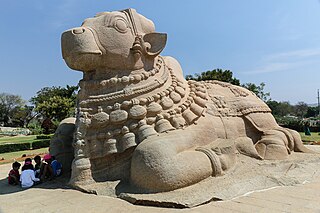
Monolithic Bull is a sculpture of Nandi in Lepakshi, India. It is also an archaeological site.


















